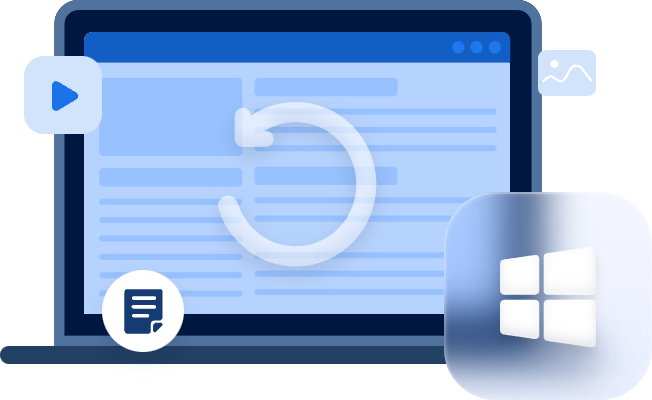How to Prevent Data Corruption by Partitioning Hard Drive
In this post, we will discuss hard drive partitioning and how to do it. In addition, you can learn how to recover data from a corrupted hard drive easily.
In our ever-evolving digital landscape, the integration of technology has become more prevalent than ever before. With the recent surge in remote work adoption, businesses face the formidable task of managing a dispersed workforce while striving to maintain operational efficiency amidst disruptions.
In this tech-driven ecosystem, the reliance on a seamless technological infrastructure is paramount. It extends beyond the choice of remote work tools and applications, encompassing hardware essentials. A functioning hard drive, though cloud storage options are widespread, remains indispensable for storing vital documents and files.
This guide will delve into the concept of disk partitioning, elucidating its significance. We will explore the advantages and drawbacks of employing this technique and furnish you with practical tips to prevent data corruption by partitioning hard drive. Besides, a partition recovery method is also introduced in this post.
Understanding Disk Partitioning
Disk partitioning entails the division of a single storage medium into one or multiple segments, typically creating distinct sections to house different types of data or files. In the initial state, hard drives come with a solitary partition to facilitate data storage.
This is because a pristine, unallocated hard drive offers no canvas for file storage. The establishment of a partition is a prerequisite, allowing for the configuration of file systems (such as NTFS, FAT32, or ext4) and the subsequent storage of data. The number of partitions varies based on user requirements.
Once partitions are in place, the operating system treats each as a discrete logical disk, enabling users to store data independently. This segregation empowers users to organize files according to their specific needs and purposes.
Tip: Windows systems often feature a recovery partition for system restoration, while Linux systems tend to be divided into multiple partitions. On occasion, Linux can coexist with Windows on a single device, each confined to separate partitions to prevent conflicts.
Disk Partitioning: Advantages and Disadvantages
Disk partitioning presents a multitude of potential advantages:
- Disk partitioning can transform your system into a virtual conglomerate of autonomous entities, without the need for additional hardware. This allows for diverse applications, including running multiple operating systems simultaneously and isolating crucial files to mitigate corruption risks.
- Furthermore, partitioning empowers efficient management of storage resources, optimizing the organization of applications and frequently accessed files. This consolidation simplifies access and reduces the time spent searching for specific data.
- Overlooked but crucial, partitioning serves as a robust security measure. In case of file corruption on one partition, others remain unaffected, preserving critical data. While this safeguards important files in the event of disk failure, it should not supplant regular backups because you can restore files from backup easily and effectively.
There are also some disadvantages of disk partitioning:
- Nonetheless, there are instances where improper partitioning can diminish overall storage space by duplicating certain administrative areas, impeding large file downloads due to sub-section limitations, and potentially compromising system performance, increasing the risk of errors and accidental data deletion.
How to Partition Your Hard Drive
How to prevent hard drive corruption by partitioning disk? To start on hard drive partitioning, Windows users can employ the Windows Disk Management tool. While third-party solutions offer extended options, Windows Disk Management suffices for most needs. Follow the clear guidelines to partition your hard drive now:
1. Locate it by searching "Disk Management" in the Windows search box.
2. After accessing Disk Management and identifying the target drive for partitioning, initiate space allocation by right-clicking and selecting "Shrink Volume." The system will ascertain available free space, enabling you to designate the desired partition size.
3. Click "Shrink" to utilize all available space or input a specific value before proceeding.
4. Subsequently, the lower half of the Disk Management screen should display unallocated space adjacent to the corresponding drive. Right-click this space and select "New Simple Volume."
5. Configure the volume size, assign a drive letter, and opt for NTFS as the file system. A quick format suffices in most cases.
6. After these steps, click "Next" until the "Finish" button surfaces. Your partition is now operational and visible within Disk Management.
How to Recover Files from a Corrupted Hard Drive
If your hard drive has been corrupted, unfortunately, efficiently recovering data from a corrupted hard drive before hard drive corruption repair demands the utilization of specialized data recovery software.
MyRecover, software boasts compatibility with various Windows operating systems and servers, promising a high success rate.
Key Features:
- Supports 200+ file types recovery, including text, photo, audio, video recovery, and so on.
- Utilizes Quick Scan and Deep Scan methods for thorough file retrieval.
- Facilitates rapid, selective file recovery during scanning.
- Preserves original file attributes during recovery.
To initiate the recovery process, download and install "MyRecover" on a functional PC. Follow these steps:
1. Connect the corrupted hard drive to the working PC with the software installed.
2. Hover the mouse over the corrupted hard drive or partition and click Scan.
3. Upon completion, review the found files and select those to recover.
4. Click "Recover x files" and specify a recovery location.
Written In the End
As our digital technology continues to evolve, the need for upskilling becomes evident. This concise guide illustrates the simplicity of hard drive partitioning and its practical benefits.
While partitioning may not be commonplace for everyday users, professionals and businesses can leverage this technique to enhance their operations. Besides, there is a way to recover files from broken hard drives in this article for you.


